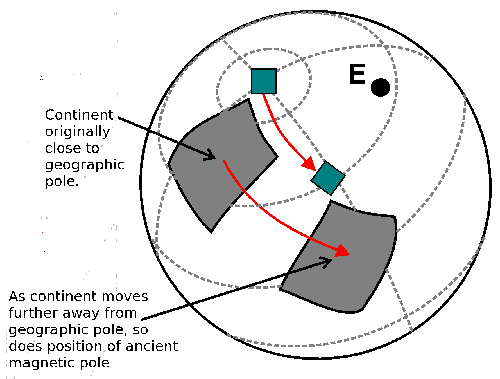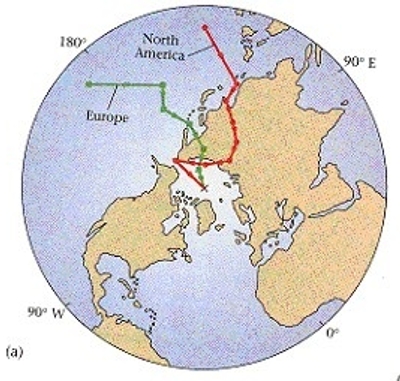 On the 1st day of Christmas my true love sent to me: an APWP
On the 1st day of Christmas my true love sent to me: an APWP
APWP stands for ‘apparent polar wander path’. The remanent magnetisation imprinted on a rock as it forms points towards the magnetic pole, and from its direction you can calculate where, geographically, the pole that the rock ‘saw’ falls on the Earth’s surface. Often, the pole position you calculate from the magnetisation directions of older rocks is some distance from the current geographic poles. It would have plotted there just after the rock formed, but after millions of years of plate motion, the continent it formed on is now at a different longitude and latitude, and hence a different distance from the geographic poles, than it was long ago. This phenomenon is called ‘apparent polar wander’, because it looks like the magnetic pole has moved with respect to the Earth’s surface, although in fact it is the Earth’s surface moving relative to the Earth’s magnetic pole.

A remanent magnetic pole which originally plots at the geographic pole will plot away from it after millions of years of plate motion
By plotting the magnetic poles for a sequence of rocks formed over tens or hundreds of million years, you get a record of continental motion over geological time: an apparent polar wander path or APWP. And if you can obtain APWPs for two different continents spanning a similar age range, you can get an idea of differential motions between them. For example, the APWPs for Europe and North America have a very similar shape between about 350 million and 100 million years ago (the sections of the lines furthest from the current geographic pole in the figure below), when they were both part of the supercontinent Pangaea and henced moved as one; indeed, if you close up the Atlantic Ocean that now separates them, the two paths will overlap.

Apparent Polar Wander Paths for North America and Europe since the Permian.
The project I’m working on at the moment is currently trying to generate APWPs for the different continents in an earlier time period, between 1000 and 500 million years ago. So this palaeomagician would love an APWP as a Christmas gift – although any sensible true love would certainly point out that I’m the one being paid to produce such a thing…
Note: this series is intended to be a light-hearted , and mildly educational, list of useful geological things. Hopefully, you don’t get too bored of this bit of seasonal whimsy before 12th night – if indeed you bother to check your RSS feeds before then!



Comments (3)
Links (1)-
Pingback: The 12 geological days of Christmas: a reprise | Highly Allochthonous